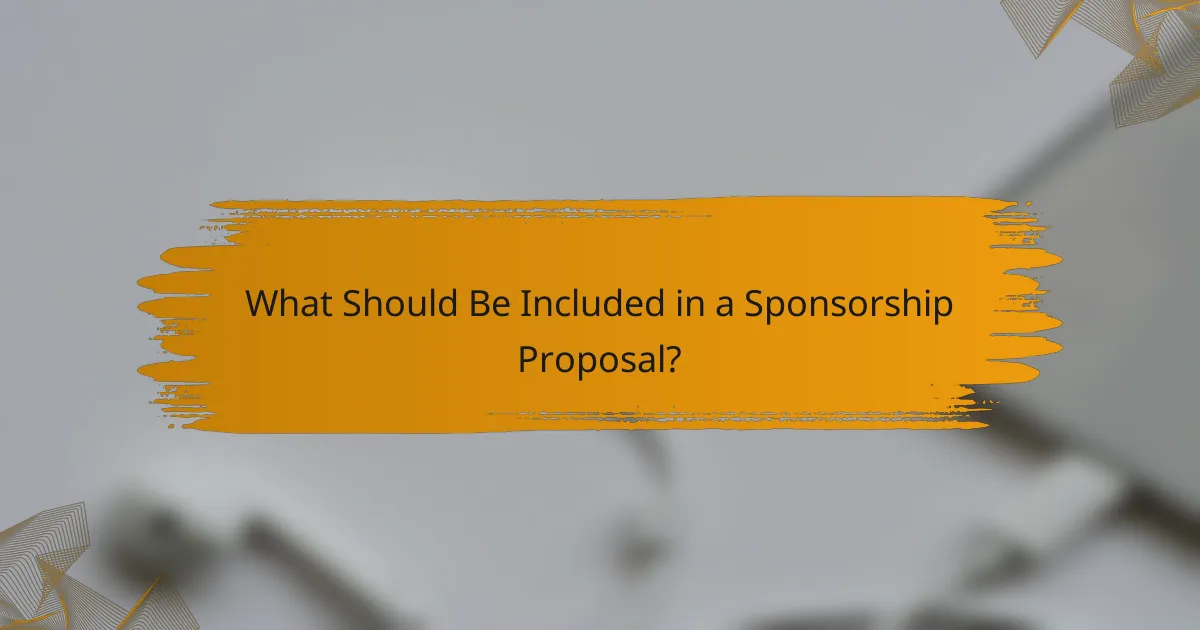Securing sponsorships requires a strategic approach that includes identifying the right sponsors, crafting compelling proposals, and fostering strong relationships. A well-structured sponsorship proposal should highlight the mutual benefits of the partnership, while effective negotiation skills are essential for reaching agreements that satisfy both parties’ needs. By focusing on these key elements, organizations can enhance their chances of attracting and retaining valuable sponsors.

How to Secure Sponsorships in the US?
Securing sponsorships in the US involves identifying suitable sponsors, presenting a strong value proposition, and building relationships. A strategic approach can significantly enhance your chances of attracting and retaining sponsors.
Identify potential sponsors
Start by researching companies that align with your audience and mission. Look for brands that have sponsored similar events or initiatives in the past, as they are more likely to be interested in your proposal.
Create a list of potential sponsors, categorizing them by industry and relevance. This will help you tailor your approach and make it easier to prioritize outreach efforts.
Craft a compelling value proposition
Your value proposition should clearly articulate what the sponsor will gain from the partnership. Highlight benefits such as brand exposure, access to your audience, and potential sales leads.
Use specific metrics to support your claims, such as audience size or engagement rates. A well-defined value proposition can differentiate you from competitors and make your proposal more appealing.
Utilize networking opportunities
Attend industry events, conferences, and trade shows to meet potential sponsors face-to-face. Networking allows you to establish personal connections that can lead to sponsorship discussions.
Consider joining relevant associations or groups where you can connect with decision-makers. Building relationships through networking can create trust and open doors for future sponsorships.
Leverage social media platforms
Use social media to showcase your brand and engage with potential sponsors. Platforms like LinkedIn, Twitter, and Instagram can help you reach a broader audience and demonstrate your value.
Share success stories, testimonials, and updates about your initiatives. Engaging content can attract the attention of sponsors and encourage them to consider a partnership.
Follow up with personalized outreach
After initial contact, follow up with personalized messages tailored to each potential sponsor. Reference specific points from your previous conversations to demonstrate genuine interest.
Be persistent but respectful; a timely follow-up can keep your proposal top-of-mind. Consider setting reminders to check in periodically, ensuring you maintain the relationship without overwhelming them.

What Should Be Included in a Sponsorship Proposal?
A well-crafted sponsorship proposal should clearly outline the value of the partnership, detailing the benefits for both parties. Key components include an executive summary, target audience details, benefits for the sponsor, budget and financial projections, and a compelling call to action.
Executive summary
The executive summary provides a concise overview of the sponsorship opportunity, highlighting the main goals and expected outcomes. It should capture the essence of the proposal in a few sentences, making it easy for potential sponsors to grasp the value quickly.
Focus on the unique aspects of the event or project, and how the sponsorship aligns with the sponsor’s objectives. A strong executive summary can set the tone for the entire proposal.
Target audience details
Understanding the target audience is crucial for any sponsorship proposal. Clearly define the demographics, interests, and behaviors of the audience that the sponsor will reach through the partnership.
Include relevant data such as age ranges, geographic locations, and purchasing power. This information helps sponsors assess the potential return on investment and tailor their marketing strategies accordingly.
Benefits for the sponsor
Detail the specific benefits that the sponsor will receive from the partnership. This could include brand visibility, access to a new customer base, or opportunities for product placement.
Be explicit about how the sponsorship can enhance the sponsor’s brand image and drive engagement. Use examples of past successful sponsorships to illustrate potential outcomes.
Budget and financial projections
Provide a clear budget that outlines the costs associated with the sponsorship and potential revenue streams. This section should include a breakdown of expenses and any expected financial returns for the sponsor.
Consider including a table that summarizes key financial figures, such as total costs, projected audience reach, and estimated ROI. Transparency in financial projections builds trust and credibility.
Call to action
The call to action is a critical element that encourages the sponsor to take the next step. Clearly state what you want the sponsor to do, whether it’s to schedule a meeting, sign a contract, or request more information.
Make it easy for the sponsor to respond by providing contact information and a timeline for follow-up. A strong call to action can significantly increase the likelihood of securing the sponsorship.

How to Negotiate Sponsorship Deals?
Negotiating sponsorship deals involves understanding both parties’ needs and finding a mutually beneficial agreement. Effective negotiation requires preparation, clear communication, and a willingness to adapt to achieve a successful partnership.
Understand the sponsor’s objectives
To negotiate effectively, first identify what the sponsor hopes to achieve through the partnership. Common objectives include brand visibility, audience engagement, and product promotion. Understanding these goals allows you to tailor your proposal to meet their specific needs.
Consider asking questions about their target audience, desired outcomes, and budget constraints. This information can guide your negotiation strategy and help you present compelling benefits that align with their objectives.
Be prepared to compromise
Negotiation often requires flexibility from both parties. Be open to adjusting your initial proposal to accommodate the sponsor’s needs while still achieving your goals. This might mean altering deliverables, timelines, or financial terms.
Establish a list of non-negotiables for your side and areas where you can be more flexible. This preparation can help facilitate a smoother negotiation process and foster goodwill between both parties.
Establish clear communication channels
Effective communication is vital throughout the negotiation process. Set up regular check-ins to discuss progress, address concerns, and clarify expectations. Use email, phone calls, or video conferences to maintain an open dialogue.
Ensure that all parties involved in the negotiation are on the same page. Designate a primary contact person for both sides to streamline communication and prevent misunderstandings.
Document all agreements
Once negotiations conclude, document all agreements in a formal contract. This should include details such as deliverables, timelines, payment terms, and any contingencies. A well-documented agreement protects both parties and provides a reference point for future discussions.
Consider having a legal professional review the contract to ensure compliance with relevant regulations and to safeguard your interests. Clear documentation minimizes the risk of disputes and helps maintain a positive relationship moving forward.

What Are the Best Practices for Managing Sponsorship Relationships?
Managing sponsorship relationships effectively involves clear communication, regular updates, and mutual benefit. Establishing trust and maintaining transparency are key to fostering long-term partnerships.
Regular updates and reports
Providing regular updates and reports is essential for keeping sponsors informed and engaged. These updates should include progress on agreed objectives, metrics of success, and any challenges encountered. Aim to schedule these reports monthly or quarterly, depending on the sponsorship’s scale and duration.
Consider using a structured format for your reports, such as a summary of activities, key performance indicators (KPIs), and future plans. This approach helps sponsors understand the value they are receiving and reinforces their investment in the partnership.
Be proactive in sharing both successes and setbacks. Transparency builds trust, and addressing challenges openly can lead to collaborative solutions that benefit both parties. Avoid waiting until the end of a sponsorship term to provide feedback; consistent communication is crucial.


